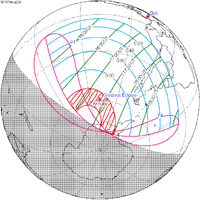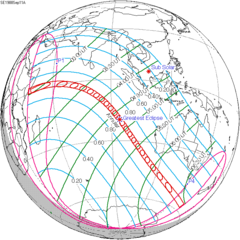September 1979 lunar eclipse
| Total eclipse | |||||||||||||||||
 The Moon's hourly motion shown right to left | |||||||||||||||||
| Date | September 6, 1979 | ||||||||||||||||
|---|---|---|---|---|---|---|---|---|---|---|---|---|---|---|---|---|---|
| Gamma | −0.4305 | ||||||||||||||||
| Magnitude | 1.0936 | ||||||||||||||||
| Saros cycle | 137 (26 of 81) | ||||||||||||||||
| Totality | 44 minutes, 25 seconds | ||||||||||||||||
| Partiality | 191 minutes, 52 seconds | ||||||||||||||||
| Penumbral | 305 minutes, 9 seconds | ||||||||||||||||
| |||||||||||||||||
A total lunar eclipse occurred at the Moon’s descending node of orbit on Thursday, September 6, 1979,[1] with an umbral magnitude of 1.0936. A lunar eclipse occurs when the Moon moves into the Earth's shadow, causing the Moon to be darkened. A total lunar eclipse occurs when the Moon's near side entirely passes into the Earth's umbral shadow. Unlike a solar eclipse, which can only be viewed from a relatively small area of the world, a lunar eclipse may be viewed from anywhere on the night side of Earth. A total lunar eclipse can last up to nearly two hours, while a total solar eclipse lasts only a few minutes at any given place, because the Moon's shadow is smaller. Occurring only about 5 hours after perigee (on September 6, 1979, at 6:00 UTC), the Moon's apparent diameter was larger.[2]
This lunar eclipse was the last of an almost tetrad, with the others being on March 24, 1978 (total); September 16, 1978 (total); and March 13, 1979 (partial).
Visibility
The eclipse was completely visible over eastern Australia, western North America, and the central and eastern Pacific Ocean, seen rising over the eastern half of Asia and western Australia and setting over North and South America.[3]
 
|
Eclipse details
Shown below is a table displaying details about this particular solar eclipse. It describes various parameters pertaining to this eclipse.[4]
| Parameter | Value |
|---|---|
| Penumbral Magnitude | 2.04211 |
| Umbral Magnitude | 1.09358 |
| Gamma | −0.43050 |
| Sun Right Ascension | 10h58m17.1s |
| Sun Declination | +06°34'46.5" |
| Sun Semi-Diameter | 15'52.1" |
| Sun Equatorial Horizontal Parallax | 08.7" |
| Moon Right Ascension | 22h58m48.1s |
| Moon Declination | -07°00'03.6" |
| Moon Semi-Diameter | 16'43.7" |
| Moon Equatorial Horizontal Parallax | 1°01'23.8" |
| ΔT | 50.2 s |
Eclipse season
This eclipse is part of an eclipse season, a period, roughly every six months, when eclipses occur. Only two (or occasionally three) eclipse seasons occur each year, and each season lasts about 35 days and repeats just short of six months (173 days) later; thus two full eclipse seasons always occur each year. Either two or three eclipses happen each eclipse season. In the sequence below, each eclipse is separated by a fortnight.
| August 22 Ascending node (new moon) |
September 6 Descending node (full moon) |
|---|---|
 |

|
| Annular solar eclipse Solar Saros 125 |
Total lunar eclipse Lunar Saros 137 |
Related eclipses
Eclipses in 1979
- A total solar eclipse on February 26.
- A partial lunar eclipse on March 13.
- An annular solar eclipse on August 22.
- A total lunar eclipse on September 6.
Metonic
- Preceded by: Lunar eclipse of November 18, 1975
- Followed by: Lunar eclipse of June 25, 1983
Tzolkinex
- Preceded by: Lunar eclipse of July 26, 1972
- Followed by: Lunar eclipse of October 17, 1986
Half-Saros
- Preceded by: Solar eclipse of August 31, 1970
- Followed by: Solar eclipse of September 11, 1988
Tritos
- Preceded by: Lunar eclipse of October 6, 1968
- Followed by: Lunar eclipse of August 6, 1990
Lunar Saros 137
- Preceded by: Lunar eclipse of August 26, 1961
- Followed by: Lunar eclipse of September 16, 1997
Inex
- Preceded by: Lunar eclipse of September 26, 1950
- Followed by: Lunar eclipse of August 16, 2008
Triad
- Preceded by: Lunar eclipse of November 4, 1892
- Followed by: Lunar eclipse of July 7, 2066
Lunar eclipses of 1977–1980
| Lunar eclipse series sets from 1977–1980 | ||||||||
|---|---|---|---|---|---|---|---|---|
| Ascending node | Descending node | |||||||
| Saros | Date viewing |
Type chart |
Gamma | Saros | Date viewing |
Type chart |
Gamma | |
| 112 | 1977 Apr 04
|
Partial
|
−0.91483 | 117 | 1977 Sep 27
|
Penumbral
|
1.07682 | |
| 122 | 1978 Mar 24
|
Total
|
−0.21402 | 127 | 1978 Sep 16
|
Total
|
0.29510 | |
| 132 | 1979 Mar 13
|
Partial
|
0.52537 | 137 | 1979 Sep 06
|
Total
|
−0.43050 | |
| 142 | 1980 Mar 01
|
Penumbral
|
1.22701 | 147 | 1980 Aug 26
|
Penumbral
|
−1.16082 | |
| Last set | 1976 May 13 | Last set | 1976 Nov 06 | |||||
| Next set | 1981 Jan 20 | Next set | 1980 Jul 27 | |||||
Saros 137
It is part of Saros series 137.
Half-Saros cycle
A lunar eclipse will be preceded and followed by solar eclipses by 9 years and 5.5 days (a half saros).[5] This lunar eclipse is related to two annular solar eclipses of Solar Saros 144.
| August 31, 1970 | September 11, 1988 |
|---|---|

|

|
See also
Notes
- ^ "September 5–6, 1979 Total Lunar Eclipse (Blood Moon)". timeanddate. Retrieved 4 January 2025.
- ^ "Moon Distances for London, United Kingdom, England". timeanddate. Retrieved 4 January 2025.
- ^ "Total Lunar Eclipse of 1979 Sep 06" (PDF). NASA. Retrieved 4 January 2025.
- ^ "Total Lunar Eclipse of 1979 Sep 06". EclipseWise.com. Retrieved 4 January 2025.
- ^ Mathematical Astronomy Morsels, Jean Meeus, p.110, Chapter 18, The half-saros
External links
- 1979 Sep 06 chart Eclipse Predictions by Fred Espenak, NASA/GSFC
- September 6, 1979, a Lunar Eclipse


